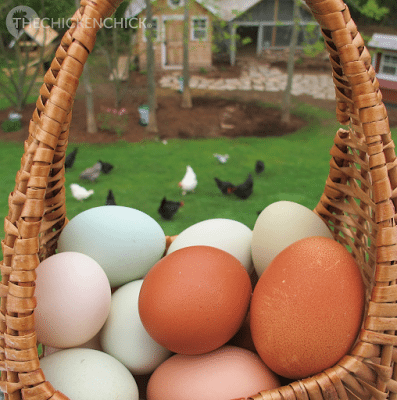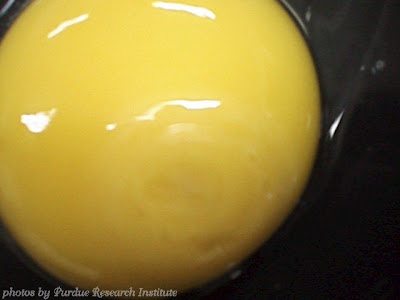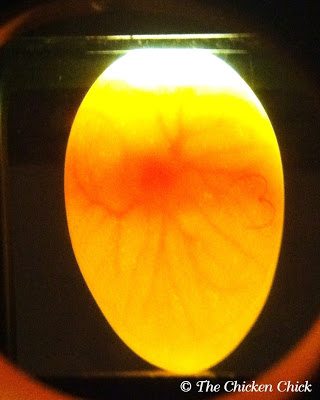There are a few common misconceptions about fertilized eggs that I hope to clear up in this article, but first, it is important to understand the differences between fertilized and unfertilized eggs as well as incubated and un-incubated fertilized eggs.
UNFERTILIZED EGGS
A hen must mate with a rooster in order for her egg to contain both the male and female genetic material necessary to create an embryo inside the egg. An unfertilized egg contains only the hen’s genetic material, which means a chick can never hatch from that egg. The hen’s genetic material, termed the blastodisc, can be identified on an egg yolk as a light-colored dot with irregular borders. Every egg contains a blastodisc.
FERTILIZED EGGS
When an egg is fertilized by a rooster, the blastodisc becomes known as the blastoderm, which is the first stage of embryonic development. The blastoderm is identified by its bullseye appearance, having regular, concentric circles. The blastoderm will remain in a state of suspended animation, so to speak, forever unless warmed at particular temperatures for several hours. When a fertile egg is incubated under precise, steady temperatures and humidity levels for 21 days, the blastoderm may develop into a chick.
INCUBATED FERTILIZED EGG
A fertilized egg must be kept at a temperature of at least 85°F for several hours in order for the blastoderm to begin developing into an embryo.
UN-INCUBATED FERTILIZED EGG
A fertilized egg that is never incubated will never contain an embryo and will never look like anything other than common breakfast food.
MYTHS & FACTS ABOUT FERTILIZED EGGS
MYTH: A fertilized egg has a baby chick in it.
FACT: Freshly laid eggs can never contain a chick. Only fertilized eggs that have been incubated under proper conditions can become an embryo and develop into a chick. To see exactly how an embryo develops, from the inside and out, each of the 21 days until it hatches, click here.
MYTH: Fertilized eggs are more nutritious than unfertilized eggs.
FACT: There is no scientific evidence that fertilized eggs are nutritionally superior to unfertilized ones. Fertilized eggs have remnants of the male’s sperm and a small layer of cells that could form the embryo. The proportion of these to the total egg is so small that it is impossible to detect chemical differences between fertile and infertile eggs.1
MYTH: Fertilized eggs taste different from infertile eggs.
FACT: There is absolutely no flavor difference between fertilized and unfertilized eggs.
MYTH: A blood spot inside the egg means the egg is fertilized.
FACT: A blood spot inside an egg can occur at various points in a hen’s reproductive system as a result of a blood vessel rupturing. It can be the result of a genetic predisposition, a vitamin A deficiency, or a random event. There is no correlation between blood spots and fertilized eggs. The misconception may have come about due to the appearance of incubated, fertilized eggs developing veins at or around day four into incubation. Veining looks nothing like a blood spot, however.
The blood in the following photo of an unincubated egg is NOT a developing embryo. The blood has nothing to do with the egg being fertilized or not fertilized, it was caused by a glitch that occurred while the yolk was being released from the hen’s ovary and would have occurred whether or not a rooster mated with the hen that laid this egg.
Looking for Walmart coupons? Save big on your next Walmart shopping trip with The Chicken Chick’s exclusive coupon codes and promotions. Don’t miss out and start saving today!
MYTH: Candling an egg will reveal whether the egg is fertilized or not. (Candling is the term used for shining a light through an eggshell to see what’s inside.)
FACT: Only eggs that are incubated and begin developing can be identified as fertilized after a minimum of 3 days. Neither the blastoderm nor a blastodisc can be seen through the shell. It is possible for an incubated egg to be fertilized and appear unfertilized when candled if the egg failed to develop. The only way to determine whether an unincubated egg is fertilized is to crack it open and identify the blastodisc or blastoderm.
Sources & further reading
Kathy Shea Mormino
Affectionately known internationally as The Chicken Chick®, Kathy Shea Mormino shares a fun-loving, informative style to raising backyard chickens. …Read on


shop my SPONSORS
There are a few common misconceptions about fertilized eggs that I hope to clear up in this article, but first, it is important to understand the differences between fertilized and unfertilized eggs as well as incubated and un-incubated fertilized eggs.
UNFERTILIZED EGGS
A hen must mate with a rooster in order for her egg to contain both the male and female genetic material necessary to create an embryo inside the egg. An unfertilized egg contains only the hen’s genetic material, which means a chick can never hatch from that egg. The hen’s genetic material, termed the blastodisc, can be identified on an egg yolk as a light-colored dot with irregular borders. Every egg contains a blastodisc.
FERTILIZED EGGS
When an egg is fertilized by a rooster, the blastodisc becomes known as the blastoderm, which is the first stage of embryonic development. The blastoderm is identified by its bullseye appearance, having regular, concentric circles. The blastoderm will remain in a state of suspended animation, so to speak, forever unless warmed at particular temperatures for several hours. When a fertile egg is incubated under precise, steady temperatures and humidity levels for 21 days, the blastoderm may develop into a chick.
INCUBATED FERTILIZED EGG
A fertilized egg must be kept at a temperature of at least 85°F for several hours in order for the blastoderm to begin developing into an embryo.
UN-INCUBATED FERTILIZED EGG
A fertilized egg that is never incubated will never contain an embryo and will never look like anything other than common breakfast food.
MYTHS & FACTS ABOUT FERTILIZED EGGS
MYTH: A fertilized egg has a baby chick in it.
FACT: Freshly laid eggs can never contain a chick. Only fertilized eggs that have been incubated under proper conditions can become an embryo and develop into a chick. To see exactly how an embryo develops, from the inside and out, each of the 21 days until it hatches, click here.
MYTH: Fertilized eggs are more nutritious than unfertilized eggs.
FACT: There is no scientific evidence that fertilized eggs are nutritionally superior to unfertilized ones. Fertilized eggs have remnants of the male’s sperm and a small layer of cells that could form the embryo. The proportion of these to the total egg is so small that it is impossible to detect chemical differences between fertile and infertile eggs.1
MYTH: Fertilized eggs taste different from infertile eggs.
FACT: There is absolutely no flavor difference between fertilized and unfertilized eggs.
MYTH: A blood spot inside the egg means the egg is fertilized.
FACT: A blood spot inside an egg can occur at various points in a hen’s reproductive system as a result of a blood vessel rupturing. It can be the result of a genetic predisposition, a vitamin A deficiency, or a random event. There is no correlation between blood spots and fertilized eggs. The misconception may have come about due to the appearance of incubated, fertilized eggs developing veins at or around day four into incubation. Veining looks nothing like a blood spot, however.
The blood in the following photo of an unincubated egg is NOT a developing embryo. The blood has nothing to do with the egg being fertilized or not fertilized, it was caused by a glitch that occurred while the yolk was being released from the hen’s ovary and would have occurred whether or not a rooster mated with the hen that laid this egg.
Looking for Walmart coupons? Save big on your next Walmart shopping trip with The Chicken Chick’s exclusive coupon codes and promotions. Don’t miss out and start saving today!
MYTH: Candling an egg will reveal whether the egg is fertilized or not. (Candling is the term used for shining a light through an eggshell to see what’s inside.)
FACT: Only eggs that are incubated and begin developing can be identified as fertilized after a minimum of 3 days. Neither the blastoderm nor a blastodisc can be seen through the shell. It is possible for an incubated egg to be fertilized and appear unfertilized when candled if the egg failed to develop. The only way to determine whether an unincubated egg is fertilized is to crack it open and identify the blastodisc or blastoderm.
Sources & further reading














































Well we must be rare! Dominique is laying 2 a day and then one of our cornish is laying, also. The cornish has a lighter brown egg than the Dominique. :) How many eggs will she need before she sits on them all? She doesnt sit on them all day.
Chickens only lay one egg per day except in very rare circumstances.
I have no interest in having baby chicks. I bought my chicks to make eggs for the family. The co-op I received my chicks from, unfortunately, were not as good at sexing their chicks as they seemed to think and I managed to have 2 roosters, which my daughter adores… The hens just started laying and I have noticed Johnny (the alpha rooster if there is such a thing), has been really getting down with the ladies and I am concerned that we will get incubated chicks. We try to collect twice a day (usually around 8am and again around… Read more »
We just got the first 4 eggs this week from our Rhode Island (pretty sure it's just 1 chicken, 2 eggs a day). We would like to raise some more layers and I was wondering what we should do if she isn't laying on them and we dont have an incubator? It looks like we may have another more maternal chicken who might have been laying on them (we found it under the deck) but she is a Seabright and super tiny. How long can they just sit before they wont form? The others haven't started laying yet, but I… Read more »
Most the time hens won't sit on them? Either way fert or not. Wow that is crazy, is that why most people use incu's? Thank so much for response. How do you ever have time? :)